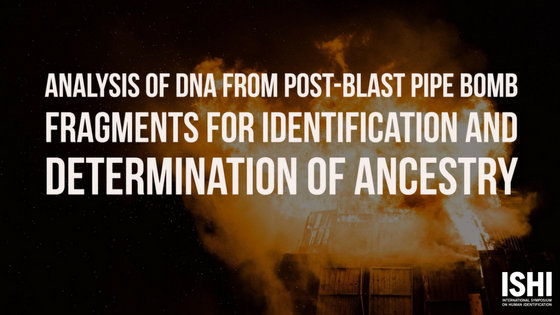Improvised explosives will continue to be the weapon of choice for homegrown and international terrorists because they are easy to manufacture and the materials are readily accessible. The ability to identify a suspect and generate investigative leads after an explosion is critical. DNA can provide leads, but traditional genotyping methods may not best suited for analyzing these types of samples. Finding new and more advanced techniques may assist with providing investigative leads, identifying potential suspects, and hopefully prevent future attacks.
Written by: Esiri Tasker, Sam Houston State University
This study examines different methods of genotyping DNA from improvised explosives and was divided into two parts. The first part examined the use of alternative genetic markers, such as insertion/null and SNPs, to genotype DNA recovered from post-blast pipe bomb fragments. The second part explored predicting ancestry from blood recovered off the end of copper wires post-blast. In addition, we used a brand of exploding targets called Tannerite® instead of traditional explosive powders. Recently, concerns about the use of Tannerite® in improvised explosive were raised because of accessibility to the product and few purchasing restrictions.
The ability to generate investigative leads after an explosion is critical to stopping terrorism. Share on X
To mimic the handling and construction of the device, a cell suspension created from buccal cells was aliquoted onto designated areas of the pipe shaft and end caps. To simulate pricking one’s finger during assembly, blood from one of three ethnically diverse individuals (Caucasian, African-American, and Asian) was added to the ends of copper wires. Prior to detonation, one wire was added to each pipe bomb. The bombs were then filled with Tannerite® powder and packed smokeless gunpowder (used as a booster), and were detonated in a remote location. The fragments were collected and brought back to the lab. Traditional STR analysis was performed using the GlobalFiler® Kit. Select post-blast samples were also analyzed using the InnoTyper® 21 Kit, which contains bi-allelic “insertion/null” or INNUL markers. HID SNP analysis (pipe bombs) and ancestry prediction (copper wires) was performed on the Ion PGM™ System using the HID-Ion AmpliSeq™ Identity and Ancestry panels.
We collaborated with Kevin Bates and the Montgomery County Fire Marshalls Office for the assembly and detonation of the bombs. Dr. Bobby LaRue and UNT Health Science Center performed the INNUL analysis using the InnoTyper® 21 Kit, which was provided by InnoGenomics Technologies, LLC.
As expected, the majority of the STR profiles produced were incomplete or there was complete amplification failure due to low quantities of DNA. The InnoTyper® 21 Kit resulted in more complete profiles compared to STRs. However, STRs were more discriminatory after 14 alleles were called. Therefore, the InnoTyper® 21 kit can be a great supplement from samples with low quantities of DNA.
HID SNPs had variable success using the maximum 6 µL of neat DNA. However, concentrating the same volume of DNA extract used for STR analysis (15 µL) to 6 µL resulted in more complete and more discriminatory SNP profiles.
The correct ancestry was predicted for five of six blood samples recovered from the copper wires. However, the confidence of these predictions was low.
About the author
Esiri Tasker is currently a doctoral student at Sam Houston State University and plans to continue on with research. After she graduates, she hopes to work in a crime lab for some time and eventually transition back into academia as a professor.
Esire became interested in this work because of the explosives; in her words, “who doesn’t want to blow up bombs in the name of science?”. But she also wanted to explore non-traditional genotyping methods that may be better suited for low-template and other challenging samples, and liked the idea of using new techniques to help solve a problem.
WOULD YOU LIKE TO SEE MORE ARTICLES LIKE THIS? SUBSCRIBE TO THE ISHI BLOG BELOW!


